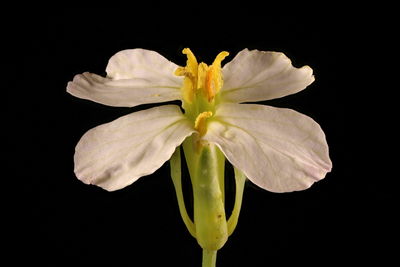Geography and distribution
It is thought that Raphanus sativus evolved in the eastern Mediterranean region and may have been selected from R. raphanistrum subspecies landra (sometimes known by the synonym R. landra ).
Radish was an important food crop in Egypt by 2,000 BC, spread to China by about 500 BC and reached Japan around 700 AD. Radish did not reach Britain until the mid-16th century.
Radish is now widely distributed, and cultivars are available to suit a wide range of environmental conditions.
Description
Overview: An annual or biennial herb with succulent taproot.
Taproot: Widely variable in colour, shape and size. Red, pink, white, yellow, purple or black externally, white to bright pink internally. Spherical, olive-, spindle- or turnip-shaped, tapering from top or bottom, 2 cm to 1m long and 60 cm in diameter.
Leaves: Lobed, with a larger, rounded, terminal lobe and smaller, paired lower segments. Irregularly toothed.
Flowers: Four white to pink or pale violet petals. Four sepals. Flowers borne on erect, many-flowered inflorescences up to 90 cm tall.
Fruit: A smooth, beaked, fleshy siliqua (fruit divided into two parts by a thin partition and opening by two valves to reveal seeds on central limb).
Many cultivars are available, including:• 'Caudatus' - rat's tail• 'Longipinnatus' - daikon, mooli, mula, muli, Chinese root, Japanese root, rettich
Cultivars commonly grown in the UK include: 'Black Spanish Round', 'Cherry Belle', 'China Rose', 'French Breakfast', 'München Bier', and many others.
Uses
Radish is cultivated as an annual for its enlarged, succulent taproot, which has been used for food since prehistoric times. The taproot is eaten raw in salads, relishes and appetizers, and slices are included in stir-fries. Black radishes are favoured in many Eastern European cuisines.
Young radish leaves are edible and are cooked in the same manner as spinach. Sprouted radish seedlings (jaba) are also consumed. Young radish fruits have a spicy flavour and are sometimes pickled. Radish was grown for its seed oil in Ancient Egypt.
Oriental radish ( Raphanus sativus 'Longipinnatus'), known as daikon or mooli, can produce a long-lasting taproot over 45 cm long and weighing up to 50 kg. This mild-flavoured taproot is widely used in oriental cuisines, for example in soups, sauces and meat dishes. In Japan it is grated to produce a garnish for sashimi. Pickled daikon is popular in Japan and Korea. Daikon is used to make 'turnip cake', which is eaten at Chinese New Year. Daikon is fed to stock in the East.
Raphanus sativus 'Caudatus', known as rat's tail, is cultivated in Asia for its fruits which grow up to 30 cm long. The young fruits are consumed raw, cooked or pickled.
Some radish cultivars are grown for their leaves, which are used as fodder.
Night of the radishes
On 23 December in Oaxaca (Mexico) thousands of people gather to celebrate Noche de rábanos (Night of the radishes).
The focus of this festival, celebrated since 1897, is the creation of intricate sculptures carved from giant radishes, many depicting nativity scenes or saints.
Millennium Seed Bank: Seed storage
The Millennium Seed Bank Partnership aims to save plant life worldwide, focusing on plants under threat and those of most use in the future. Seeds are dried, packaged and stored at a sub-zero temperature in our seed bank vault.
Three collections of Raphanus sativus seeds are held in Kew's Millennium Seed Bank based at Wakehurst in West Sussex.
This species at Kew
Raphanus sativus can usually be seen growing in the Plant Family Beds at Kew.
Pressed and dried specimens of Raphanus sativus are held in Kew's Herbarium where they are available to researchers by appointment. Details of specimens of Raphanus species can be seen online in Kew's Herbarium Catalogue.
Specimens of radish roots, seeds, seed oil and fruits are held in Kew's Economic Botany Collection in the Sir Joseph Banks Building, where they are available to researchers by appointment.





























